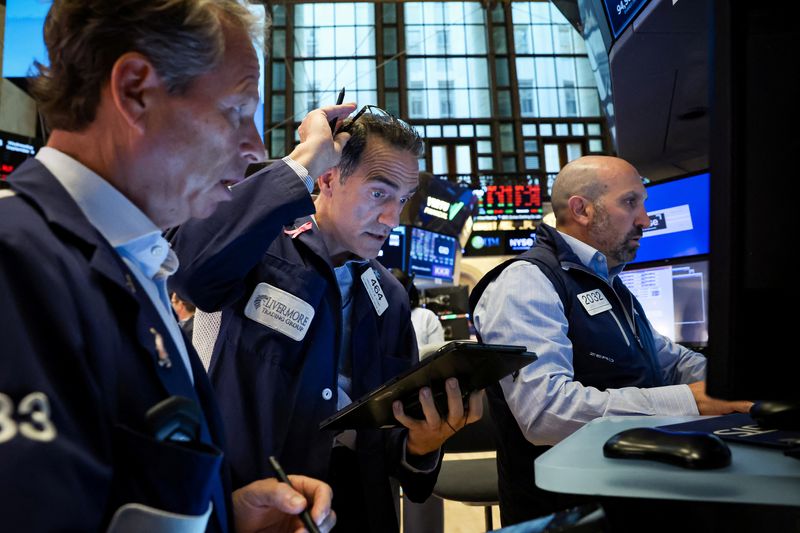By Sinéad Carew and Marc Jones
NEW YORK/LONDON (Reuters) -MSCI's global equities index edged down on Thursday as investors digested mixed economic data while they anxiously waited for Friday's crucial U.S. jobs report and oil prices held near 14-month lows as demand worries offset draws on inventories.
U.S. Treasury yields fell and two-year yields reached a 15-month low after ADP's private sector August jobs data showed fewer new jobs than anticipated.
Thursday's data showed U.S. private employers hired the fewest workers in 3-1/2 years in August while the July number was revised lower, potentially hinting at a sharp labor market slowdown.
The weak data did little to calm investor jitters as they waited for Friday’s U.S. non-farm payroll report for August, which is expected to clarify how fast the U.S. Federal Reserve will cut interest rates at its September meeting. Economists are expecting 160,000 new jobs for August up from 114,000 in July.
While bets have increased to 41% from 34% a week ago that the Fed might kick-off its long-awaited easing cycle with a half percentage point move this month, traders still see a roughly 59% probability that the cut will just be a quarter of a percentage point according to CME Group's (NASDAQ:CME) FedWatch tool.
On Tuesday, Wall Street indexes had suffered their biggest daily losses in almost a month as investor anxiety about the U.S. economy intensified.
Tuesday's decline "did some damage to the psyche of the majority of the bulls and kept people a little more nervous yesterday and today," said Michael James, managing director of equity trading at Wedbush Securities in Los Angeles.
"Today's data was similarly softer making it more likely we're going to have a meaningful move in the market on the jobs report tomorrow morning," said James, noting that "increased anxiety levels will bring about more trimming of positions than adding to positions."
Still, Thursday's data also showed steady U.S. services sector activity in August with the Institute for Supply Management's non-manufacturing purchasing managers index at 51.5 last month compared to 51.4 in July.
But while the services data appeared to encourage traders earlier in the U.S. trading session, stock indexes lost steam as the day wore on and investors braced for Friday's data.
On Wall Street, the Dow Jones Industrial Average fell 219.22 points, or 0.54%, to 40,755.75, the S&P 500 lost 16.66 points, or 0.30%, to 5,503.41 and the Nasdaq Composite gained 43.37 points, or 0.25%, to 17,127.66.
MSCI's gauge of stocks across the globe fell 1.79 points, or 0.22%, to 813.26, showing its fourth straight day of declines. Earlier in the day, Europe's STOXX 600 index had closed down 0.54%.
In currencies, the dollar eased in a choppy session as investors prepared themselves for Friday's U.S. payrolls report.
The dollar index, which measures the greenback against a basket of currencies including the yen and the euro, fell 0.17% to 101.09.
The euro was up 0.22% at $1.1106, while against the Japanese yen, the dollar weakened 0.2% to 143.44.
In Treasuries, the yield on benchmark U.S. 10-year notes fell 3.9 basis points to 3.729%, from 3.768% late on Wednesday, while the 30-year bond yield fell 4.7 basis points to 4.0207%.
The 2-year note yield, which typically moves in step with interest rate expectations, fell 2.2 basis points to 3.7476%, from 3.77% late on Wednesday.
And a closely watched part of the U.S. Treasury yield curve measuring the gap between yields on two- and 10-year Treasury notes, seen as an indicator of economic expectations, was at a negative 2.1 basis points.
In energy markets, oil ended the session barely changed as worries about demand in the U.S. and China and a likely rise in supplies out of Libya offset a big, bullish withdrawal from U.S. inventories and a delay to output increases by OPEC+ producers.
U.S. crude settled down 0.07% or 5 cents at $69.15 a barrel for its lowest close since December for the second straight day.
Brent crude closed at $72.69 per barrel, down 1 cent on the day for its lowest close since June 2023 for a third day in a row.

Gold prices gained as the U.S. dollar and Treasury yields fell as signs the labor market was losing steam led investors to consider a super-sized rate cut from the Fed.
Spot gold added 0.85% to $2,515.31 an ounce. U.S. gold futures gained 0.57% to $2,507.60 an ounce.
